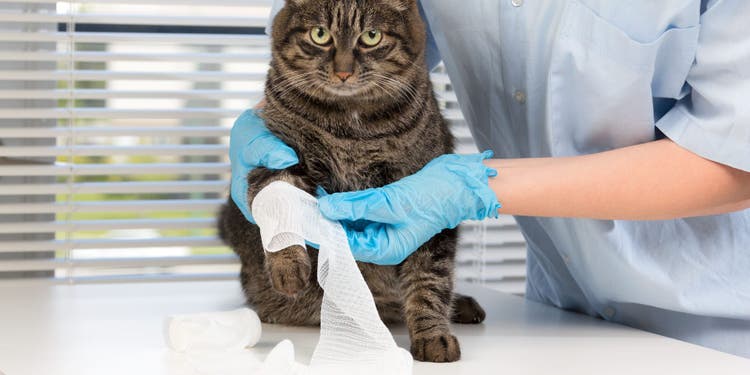
Plasma Cell Pododermatitis in Cats
Plasma cell pododermatitis, commonly referred to by the names Pillow Foot or Pillow Paw, is a disease of the footpads that can occur in some cats. The medical term “pododermatitis” literally means inflammation of the skin on the foot. It is known for its surprising appearance of spongy, doughy, and large footpads. The disease can involve only one pad or both front (metacarpal) pads and rear (metatarsal) pads with the center pad being most frequently involved. In some light colored cats, a little purple-violet color to the pads may be noted with small striations.
The cause of feline plasma cell pododermatitis is largely unknown. A common theory involves an immune-mediated mechanism that activates lymphocytes and plasma cells. The paw pad is infiltrated with these cells, causing swelling and a soft doughy and almost “pillowy” appearance.
Plasma cell pododermatitis can affect any sex, age, or breed of cat. Some affected cats may be infected with Feline Immunodeficiency Virus (FIV). The exact connection between cats with plasma cell pododermatitis and those with FIV is unclear. Some studies estimate that 50% of cats with plasma cell pododermatitis are positive for FIV.
What to Watch For
Many cats have the classic appearance of pillow paws but it does not cause problems. These cats will generally have swollen puffy but non-painful pads. On the other hand, some cats will have the following signs:
- Some pads will ulcerate which appears as red, inflamed, painful lesions
- Some pads will split open leading to infection and discharge
- Bleeding from paw pads
- Excessive licking of feet pads
- Lameness
- Decreased appetite or anorexia
- Regional lymph node enlargement in come cases
Diagnosis of Plasma Cell Pododermatitis in Cats
The diagnosis of feline plasma cell pododermatitis is largely based on the physical examination and characteristic puffy pad swelling. Additional tests may include:
Routine blood work may reveal an increase in gamma globulins (hypergammaglobulinemia)
Fine needle aspirates (FNA) or biopsy of the pads may reveal an increased number of plasma cells
Feline leukemia virus (FeLV) and feline immunodeficiency virus (FIV) are recommended to determine if concurrent disease is present.
Treatment of Plasma Cell Pododermatitis in Cats
Treatment options vary depending on the individual cats clinical signs or symptoms. Many cats are not symptomatic and do not require treatment.
Treatment for cats that are symptomatic may include:
- Keep cats indoors out of environmental extremes of hot and cold that may cause damage to the pads.
- Oral glucocorticoids (such as prednisolone or dexamethasone) may be recommended. Steroids may be given daily then tapered to the lowest effective dose. The goal of the steroids is to decrease the core immune response.
- Immunosuppressive drugs such as Cyclosporine (Atopica) may be use in some cats that do not respond to steroid therapy.
- Antibiotics such as doxycycline may be used to treat ulcerations and infections. Treatment may be recommended for 1 to 2 months or longer. Doxycycline is thought to have properties as being both effective as an antibiotic and containing immunomodulating properties.
- Surgical removal of severely infected, ulcerated or painful pads may be a recommended treatment options in some cats.
- Use unscented litter and paper-based cat litter may be helpful to minimize litter debris being stuck to painful pads.
- Gentle cleaning of the paw pads may be helpful to remove litter debris.
Most symptomatic cats will respond to medical therapy within one to two months. Some cats with pododermatitis may have concurrent kidney disease (amyloidosis) or an oral infection (plasma cell stomatitis). The prognosis is worse in cats with concurrent disease or those that are also positive for feline leukemia virus or feline immunodeficiency virus.
Prognosis for Cats with Plasma Cell Pododermatitis
The prognosis for cats with Plasma Cell Pododermatitis will vary depending on the severity of the condition and the cat’s individual response to treatment. Please follow your veterinarian’s recommendations for treatment.
Resources & References:
- Current Veterinary Therapy XV, Bonagura and Twedt.
- Plumb’s Veterinary Handbook by Donald C. Plumb, 9th Edition.
- Textbook of Veterinary Internal Medicine, Ettinger & Felman.
- Handbook of Small Animal Practice, Rhea V. Morgan, 3rd Edition.